The easy answer is yes – but if that was all there was to it, then this would be a VERY short article!




The easy answer is yes – but if that was all there was to it, then this would be a VERY short article!

Firstly let me say that I like school dinners – well, not all options offered in school dinners ….pink custard I especially hate! But the great thing about being a teacher having school dinners is “you can’t be told to eat it.”

Is it possible to integrate older reading books into our class library and reading scheme or should we just be throwing them out?
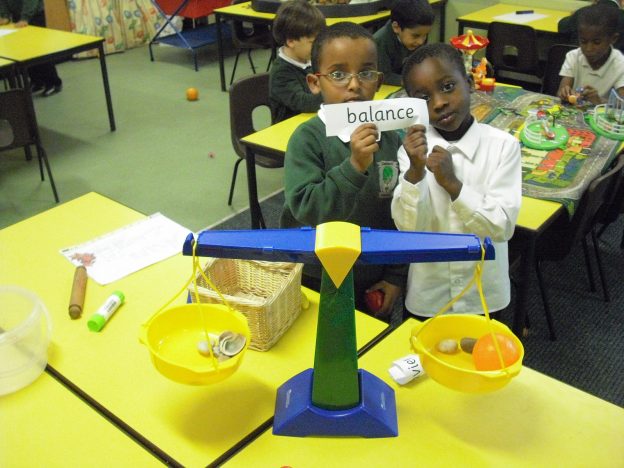
Well in actual fact I am often teaching 3 maths topics at one time – but before you ask, no there are no carousel arrangements, no smoke and mirrors and I don’t magically appear in hologram form at various points in the classroom!

I have to say I can’t write about this subject without a smile on my face – so don’t expect a scientific analysis in anything I write!

I visited a school a couple of weeks ago and they were obviously having a bit of a clear out – there was a skip at the side of the school full of rubbish and on top I was surprised to see some whiteboards…nothing wrong with them just surplus to requirements! I have to say I was tempted to ask for one!
With the almost total fitting of Smart boards of every type and brand in classrooms it seems that the days of the whiteboard are numbered – well they certainly were in this school! But is it really progress to get rid of them altogether or do they still have a place in our classrooms?
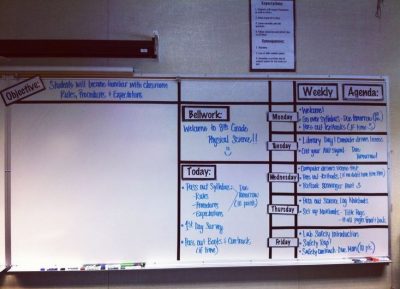
I like a whiteboard – there I have said it….no I really do, and I am not convinced that removing them from classrooms is a good thing. So let me explain my argument –
Now I am not saying that I dislike smart boards (for want of a generic name) – I understand their versatility and all the exciting options that they bring. But they do bring with them some disadvantages and limitations and I am never too sure about the health aspects of large TV screens being on all day! ( I have written about this in another article – linked below)
http://pp.distractweb.co.uk/2016/11/18/class-screens-what-do-we-see-in-them/
However lets consider some of the advantages of whiteboards and why I like having one in a classroom.
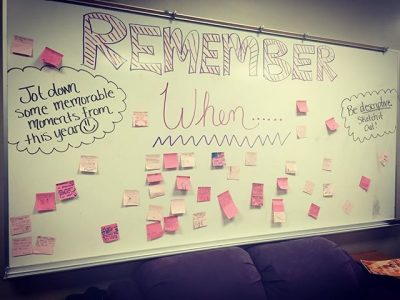

As you can no doubt tell by now, I like having a whiteboard in my classroom – I certainly always had a whiteboard in my HT’s office and I even have a whiteboard in my kitchen at home!
But in saying this about whiteboards does not mean I am not in favour of smart boards in classrooms. In fact quite the opposite. The inclusion of these type of boards brings with it new and exciting elements and experiences to the education of the children and allows teachers to use the vast array of resources available both from the internet and also specific to the technology itself.
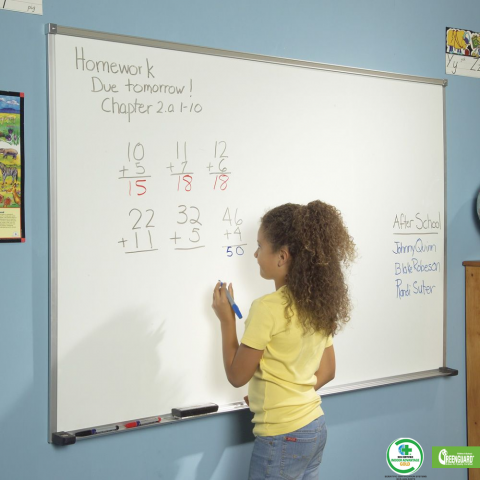
But and it’s a big but – in my opinion it is a mistake to replace whiteboards with the new smart boards. There is a definite place in the classroom for both these resources and it should not be a choice of one at the expense of the other.
Many schools are now starting to realise this and I know of 3 schools who have bought new whiteboards to replace those they had previously removed.

With a bit of careful planning and rearrangement both can be productively used in both extending and consolidating the classroom learning experience.


Do you use a carpet sitting area in your classroom – do you physically have the space to create one and are they really worth having?

Its not very often that I venture into teaching or lesson content as Primary Practice is really all about the practicalities of schools, classrooms and being a teacher.
However I thought today I would give a few thoughts on the teaching of spellings in Primary schools as it has changed markedly over the years and I have to say for the better!
These are broad based thoughts and not in any way definitive – each school will have its own approach to the teaching of spelling and its own combination of strategies – if it works then that’s all that matters.
The National Curriculum requirements:
The guidelines on spelling are really split into 2 sections – one for each key stage.
In key stage 1 the teaching of sounds and patterns is prominent however it is also said that the words given as examples including the exception words should really be taught.
At key stage 2 the word list are statutory and some guidance is given to support their teaching. The NC recommends that phonics teaching is continued as well as the relevance between meaning and spellings.
Spellings are now tested in the KS2 SAT’s in Year 6.
The requirements as set out in the national curriculum are pretty specific and this therefore necessitates that schools must have an organised and progressive approach to the teaching of spelling in order to achieve success in this important area.
There are 4 basic areas involved in a combined approach:
You may use others in your school or they may be variants of the above – but as I have said previously it must be specific to your particular school and the needs of your children.
Phonics:
In my opinion the teaching of phonics now needs to be across the whole school and should not end in KS1.
Many schools have noticed that for varying numbers of pupils their phonic foundations can be poor and of course this leads to increasing problems as the work rate and complexity increases across KS2. In teaching phonics in KS2 it provides opportunity to support these identified children whilst also extending phonics in an active teaching programme.
There are many examples of good phonics programmes that can be used – but for no other reason than I have personally used this one, I will use it as an example here.
The Collins Phonics and Spelling publications extend right across the Primary age range from Rec to Y6 and provides either support for a phonics programme already used in school or as we used it, as a teaching aid for each age group. There are puzzles, games and quizzes. Each level is directly linked to the appropriate spelling objectives and there are differentiation and homework ideas. ( I could almost be on commission!)
Key stage 1 had their own approach to the teaching of phonics based on “letters and sounds” (the gov’t scheme) and Jolly phonics but at KS2 we used to teach phonics every morning for 20 minutes at the beginning of the day based on the Collins scheme.
I have to say that this focus within KS2 had an immediate and positive effect, not only on the pupils spelling but also in their written work and spoken vocabulary.
Links to handwriting:
It is not my intent to delve into the studies and theories behind such links. Most schools now have a taught programme for handwriting across the school. There are proven links between spelling and handwriting and as such, a linked school programme both consolidates and reinforces the taught phonics element incorporated in written spelling patterns.
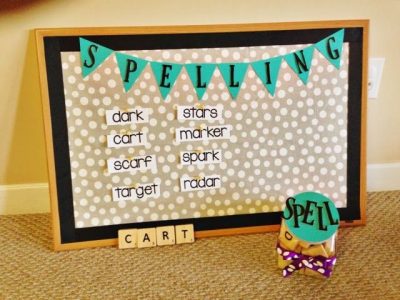
Displays:
Classroom displays are a useful and integral part of the spelling programme – especially if they also incorporate a “working wall” in part of whole.
Displays to reinforce current spelling focus or to encourage spelling challenges or games can bring a colourful and fun element directly into class life which of course is always great!
Not all displays need to directly relate to a taught phonics or spelling programme and topic display boards may contain “topic words” that are important for the children to know and use in their written work.
Here’s a few examples of boards….
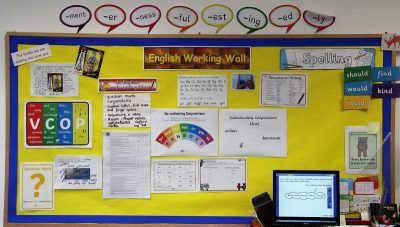

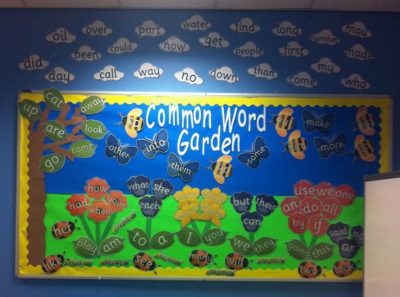 and finally why not go BIG!
and finally why not go BIG!
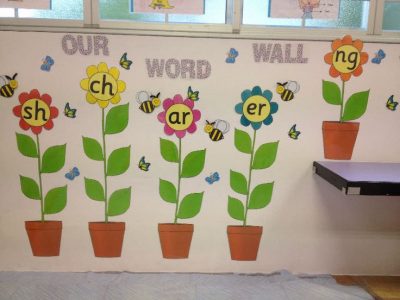
Homework:
Depending on the schools policy towards homework this may possibly provide another option.
Personally I have always sent spellings home to be learnt each week. Using 3 spelling groups in the class, each group was set 10 spellings every Monday to be learnt for a test on Friday. The test not only being on the words themselves but also in sentences to provide context and understanding.
Dependent on the levels and needs of the class; written homework can be set either to indirectly require the use of current phonetic class learning or in some cases, directly to practice and consolidate specific areas.
Again Collins produces Phonic support materials that can be used at home should there be a need for extra support and practice for some pupils..
So there are some thoughts on approaches to teaching spellings in the Primary age range. I am sure that every school will have or will be evaluating their own structures to ensure that all children make maximum progress and achieve success in this vital area. Spellings are a cornerstone of a Childs language; reading, writing, speaking and understanding. They cannot, in my opinion, be taught in isolation as each element is intertwined with all the others – and as such must be taught in a combined approach.
I have seen, on my travels, many many examples of excellent and outstanding practice and have enjoyed hearing and reading examples of terrific work from very proud pupils. It is certainly a testament to the hard work of dedicated colleagues up and down the country and the success speaks for itself.

Charles

You will all, I am sure, have been on a training course or had an advisor into your school who gives a demonstration lesson.

With the current emphasis in the Primary curriculum on Maths and Literacy (and I predict Science very soon) it is all too easy for schools to push the other subjects – the foundation subjects to one side and to grant them less importance.